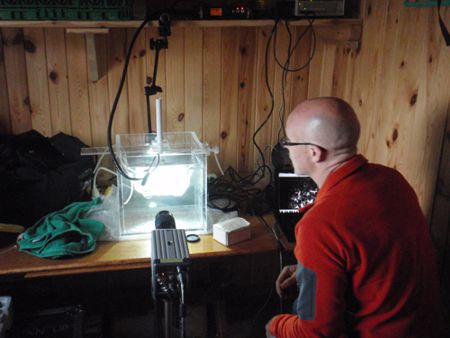Last time, I talked at length about the science, and why we are here. But it's not all work in the field. Arctic weather changes fast, and even the best forecasts (using data from the weather station 100 m away) are not as accurate as local scientists. By looking at the wind and the sea, they can predict much more accurately when it is worth going out, when we should think about going back home in a hurry, or when we can carry on ... Sometimes, in a bright blue sky, Jarek will say: "OK, in 30 minutes, we should start back". And once we have cut short the experiment, and started going home, we already see fast winds and increasing waves moving in ... That's field experience worth listening to.
When the weather is not as good, or just when we have plenty of iceberg samples to study in detail, we do experiments using two setups. Mine is simple, with a small tank and a high-precision hydrophone to record the noise from an iceberg as it melts, from start to finish. We keep our samples in the station's deep freezer, at -23 degrees (Celsius). The cook nicely put the frozen fish to one side, and we have the other half for all sorts of icebergs, cleanly packed and well separated.
Grant Deane, our American colleague (but originally from New Zealand), has designed and built a separate rig to take high-speed photographs of small samples of ice as they melt, and to record the very short bursts of noise they make each time a bubble escapes, or something else noisy happens. To hold the tiny samples, Jarek Tegowski built a special holder, which adapts to the melting as the samples become smaller and smaller and smaller.

Respond